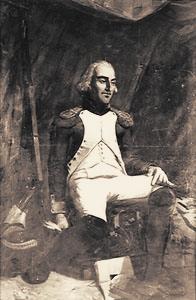The directory «Plots»
La Tour d'Auvergne Theophile Malo Corret de
(1743—1800)

French soldier, was born at Carhaix in Brittany on the 23rd of December 1743, the son of an advocate named Corret. His desire for a military career being strongly marked, he was enabled, by the not uncommon device of producing a certificate of nobility signed by his friends, first to be nominally enlisted in the Maison du Roi, and soon afterwards to receive a commission in the line, under the name of Corret de Kerbaufret. Four years after joining, in 1771, he assumed by leave of the duke of Bouillon the surname of La Tour d'Auvergne, being in fact descended from an illegitimate half-brother of the great Turenne. Many years of routine service with his regiment were broken only by his participation as a volunteer in the due de Crillon's Franco-Spanish expedition to Minorca in 1781. This led to an offer of promotion into the Spanish army, but he refused to change his allegiance. In 1748 he was promoted captain, and in 1791 he received the cross of St Louis. In the early part of the Revolution his patriotism was still more conspicuously displayed in his resolute opposition to the proposals of many of his brother officers in the Angoumois regiment to emigrate rather than to swear to the constitution. In 1792 his lifelong interest in numismatics and questions of language was shown by a work which he published on the Bretons. At this time he was serving under Montesquiou in the Alps, and although there was only outpost fighting he distinguished himself by his courage and audacity, qualities which were displayed in more serious fighting in the Pyrenees the next year. He declined well-earned promotion to colonel, and, being broken in health and compelled, owing to the loss of his teeth, to live on milk, he left the army in 1795. On his return by sea to Brittany he was captured by the English and held prisoner for two years. When released, he settled at Passy and published Origines gauloises, but in 1797, on the appeal of an old friend whose son had been taken as a conscript, he volunteered as the youth's substitute, and served on the Rhine (1797) and in Switzerland (1798-1799) as a captain. In recognition of his singular bravery and modesty Carnot obtained a decree from the first consul naming LaTour d'Auvergne " first grenadier of France " (27th of April 1800). This led him to volunteer again, and he was killed in action at Oberhausen, near Donauworth, on the 27th of June 1800.
La Tour d'Auvergne's almost legendary courage had captivated the imagination of the French soldier, and his memory was not suffered to die. It was customary for the French troops and their allies of the Rhine Confederation under Napoleon to march at attention when passing his burial-place on the battlefield. His heart was long carried by the grenadier company of his regiment, the 46th; after being in the possession of Garibaldi for many years, it was finally deposited in the keeping of the city of Paris in 1883. But the most striking tribute to his memory is paid to-day as it was by order of the first consul in 1800. " His name is to be kept on the pay list and roll of his company. It will be called at all parades and a non-commissioned officer will reply, Mart au champ d'honneur." This custom, with little variation, is still observed in the 46th regiment on all occasions when the colour is taken on parade.
Cooê Islands, 1986, Ossian receiving French Officers
Cooê Islands, 1986, Ossian receiving French Officers
France, 1991, La Tour d’Auvergne
France, 1991.06.01,  Carhaix Plouguer. La Tour d’Auvergne
Carhaix Plouguer. La Tour d’Auvergne